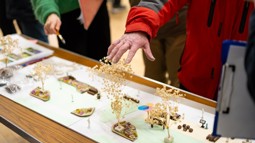We’re the charity making it possible for everyone to walk, wheel and cycle. For longer journeys, that might mean walking to the bus or cycling to the train. MPs in the Transport Select Committee recently asked for ideas for how to make this easier, and this is what we’ve said.

People generally walk relatively short distances, but they’ll cycle further. Credit: Walk Wheel Cycle Trust
When did you last get the bus? Think about the journey
How was it? Warm, cold? Bumpy? Easy to pay? Late? Did you feel safe?
All these factors are important to think about if we’re going to make it the logical choice for people to use public transport to get around. But there’s something we often forget, which is just as important: your experience getting to and from the bus.
Almost all bus journeys start with a walk or wheel. If you’re changing between the bus and the train, the accessibility of that short walk or wheel can determine whether the journey is possible.
If we want to help people take public transport more, we need to think about different parts together.
Because of that, the transport select committee are conducting an inquiry into “joined-up journeys” which use different transport modes. Here’s what we’ve said.
Walking and wheeling are the glue that holds together an integrated transport system
Changing between modes is the worst rated part of “multi-modal” trips, according to a Department for Transport survey.
The interchange is almost always a walk or wheel, so making that more pleasant is crucial.
That means fixing cracked paving, providing slopes or lifts for people who struggle with stairs or escalators, and using all the other solutions to improve any walking or wheeling journey.

What was your last bus journey like? Credit: Walk Wheel Cycle Trust
Cycling has massive untapped potential
People already walk or wheel to the bus or train.
People generally walk relatively short distances, but they’ll cycle further. If you build a new train station and make it easy to walk there, that’s great.
But if you make it easy to cycle there as well, you’ve increased the catchment by 20 times, based on the average length of walks and cycles.
How can we help people walk, wheel and cycle to the bus or train?
At Walk Wheel Cycle Trust, we’re working to make it easier for people to make these longer journeys by connecting the National Cycle Network to bus stops and train stations. Now, councils and national governments need to play their part.
Here are three ways they can do this:
First, they need to prioritise building housing densely, near public transport services. Since the 1970s, guidance has highlighted that people should live within 400m of a bus stop.
Some councils do this well, but it’s not consistent. That needs to change. It needs to be given more weight, within National Planning Practice Guidance.
Second, we need to change our mindset. Joined-up transport will not be possible while we continue to prioritise the car above other modes of transport.
In many areas the car is still king – in how we create business cases for transport schemes, in how we design junctions. Cars are helpful tools, but they shouldn’t be elevated above everything.
So, in the government’s upcoming Integrated National Transport Strategy, they should signal a change of approach. They should set targets for what we all want to happen: a higher proportion of journeys being made by public transport, walking, wheeling or cycling.
Finally, we need to provide choice. Having various options not only caters for different people, it also allows for different needs on different days.
One day, you might be carrying a lot, so you’d like to take the tram. Another day, you might want to get some exercise on your way, so you choose to cycle. Having a safe route to cycle but also a convenient public transport option makes that possible.
And it makes us happier! A study on multi-modal journeys found that people with more than one option of how to travel are more satisfied, even if they always take the same one.

Almost all bus journeys start with a walk or wheel. Credit: Walk Wheel Cycle Trust
Let’s learn from the positives
We can often get despondent when talking about transport – focusing with the problems now, rather than thinking about what we could have.
That’s why people find it so inspiring to look at positive examples, whether that’s London, the Netherlands or Japan. We should learn from them.
What’s the best experience you’ve ever had of a joined-up journey? What could we learn? Why not tell your council about it, so that they can learn from it?

Our strategy
Read more about how we’re making long journeys possible for everyone by making it easy to walk, wheel or cycle to catch a bus, tram or train in our new strategy.




